Aircraft carriers may “rule the seas,” but even they do not have immunity from disasters at sea. To quote the 1973 U.S. Navy training film Trial By Fire: A Carrier Fights for Life, “Yet for all this vast strength, as real as it is apparent, a carrier at sea is extemely vulnerable since her striking arm requires the use of exotic fuels and powerful weapons. She is forced to carry with her the potential for her own destruction. It’s all around her, on and below decks, waiting—waiting for a miscue, a careless error, or a tragic accident.”
Since the members of a ship’s crew are human like anyone else, when thousands of souls embark on a carrier they have no choice but to put their lives in their shipmates’ hands. They have to trust the rules and procedures designed to best mitigate the hazards of such a dangerous environment.
There is no telling how many times sailors onboard an aircraft carrier have flirted with disaster, and simply been lucky. During the 1960’s, as the Vietnam War brought American sailors into major combat conditions for the first time since the Korean War, three aircraft carriers were not so lucky.
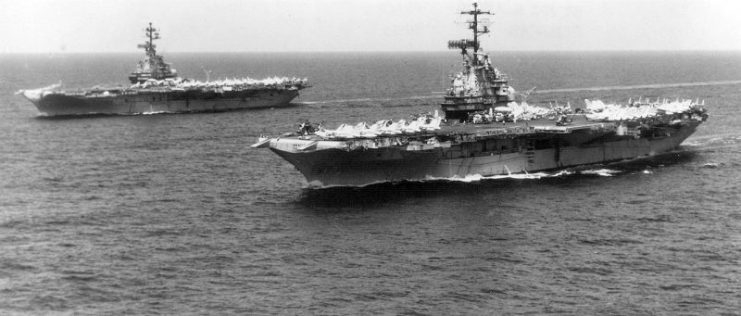
USS Oriskany (CV 34), 27 October 1966
Oriskany was no stranger to fire during combat operations. During the Korean War, a “hung” bomb on a F4U Corsair fighter broke loose and exploded as the aircraft landed, killing 2 and injuring 14 sailors. But that paled in comparison to the conflagration that struck the ship 13 years later.
Oriskany had been at Yankee Station in the Gulf of Tonkin since early July 1966, conducting airstrikes against North Vietnam. On October 27, a three-foot-long magnesium parachute flare somehow ignited while a sailor was handling it in the ship’s hangar bay. The sailor reportedly panicked and threw the flare, burning at 5,400º F, back into the “flare locker,” a space which held at least 700 more flares. Those also ignited, resulting in an explosion that blasted open the locker’s steel bulkheads.
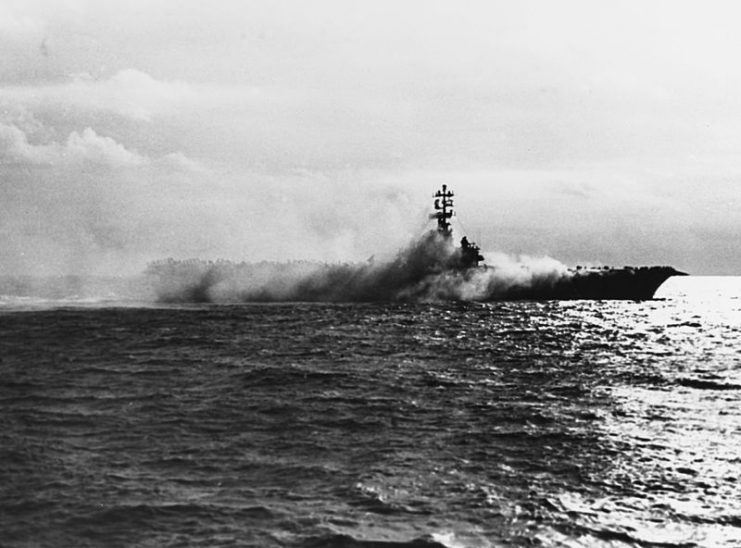
The explosion itself, the chemical fire, and the suffocating smoke from the burning magnesium—which cannot be put out with water, rendering the hangar bay sprinkler system useless—caused 38 sailors to be injured, 3 aircraft destroyed, and 3 aircraft damaged.
Worse, 43 sailors died, mostly pilots who had been sleeping in nearby staterooms when the explosion occurred, and succumbed while trapped by the intense heat and smoke.
Oriskany was forced to depart to San Francisco Bay Naval Shipyard to repair the extensive damage. She would return to the combat zone in July 1967.
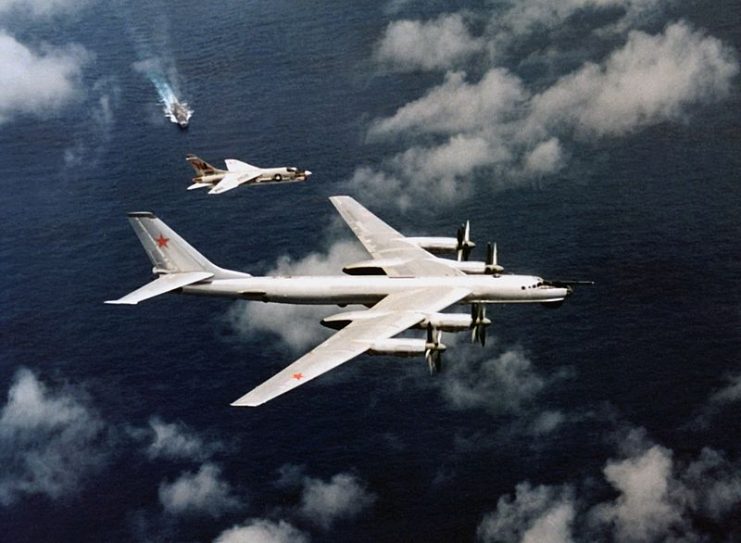
USS Forrestal (CV 59), 29 July 1967
Oriskany arrived back at Yankee Station in time to be witness to, and aid in, a shipboard disaster that far eclipsed her own. The Forrestal fire marks the second worst loss of life on a Navy ship after World War II.
https://youtu.be/mSRnjWACVOc
Forrestal had arrived in theater just six days previously and was beginning her fifth day of airstrikes against North Vietnam. Many factors united to create the deadly conditions that led to tragedy.
For instance, some ordnance handlers followed loose procedures that violated Navy safety regulations. Some equipment had material deficiencies. Also, due to a shortage of Mk-83 bombs, the Navy supplied Forrestal with badly deteriorated AN-M65 1,000-lb bombs left over from the Korean War.
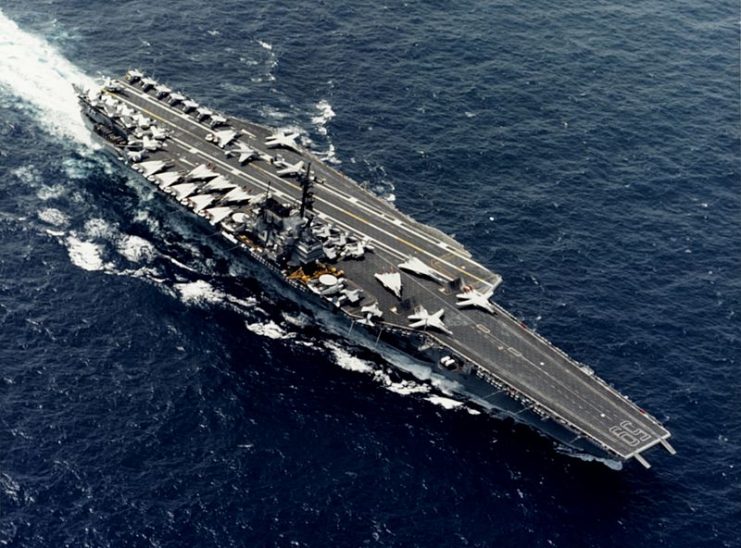
A major factor was that, aside from the sailors who had been specially trained as firefighters, most of the crew and especially the air wing were generally ignorant of proper shipboard firefighting and damage control procedures.
World War II had proven the value of training all sailors to fight fires, but the practice had lapsed over the years. On top of that, damage control equipment had not been sufficiently updated over time to keep pace with changing combat conditions.
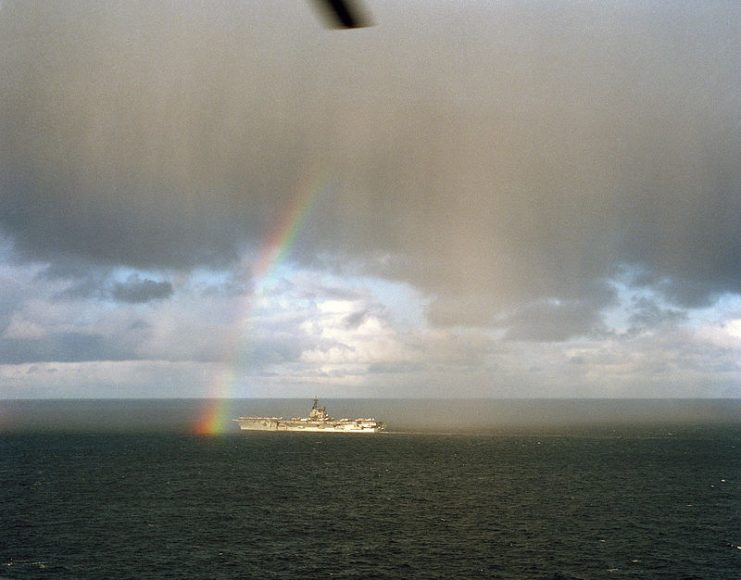
That fateful day, 27 aircraft were staged on Forrestal‘s flight deck, fully fueled and bristling with various bombs, missiles, rockets, and 20 mm ammunition. Everyone was busily preparing for an 11:00 AM launch. But at 10:51, a power surge in an F-4 Phantom triggered the inadvertent firing of one of the Phantom’s Zuni rockets.
The flash from the rocket was recorded by the ship’s Pilot Landing Aid Television (PLAT) camera. The Zuni crossed the flight deck and struck an A-4 Skyhawk 100 feet away, rupturing its 400-gallon fuel tank and igniting the spilling fuel.
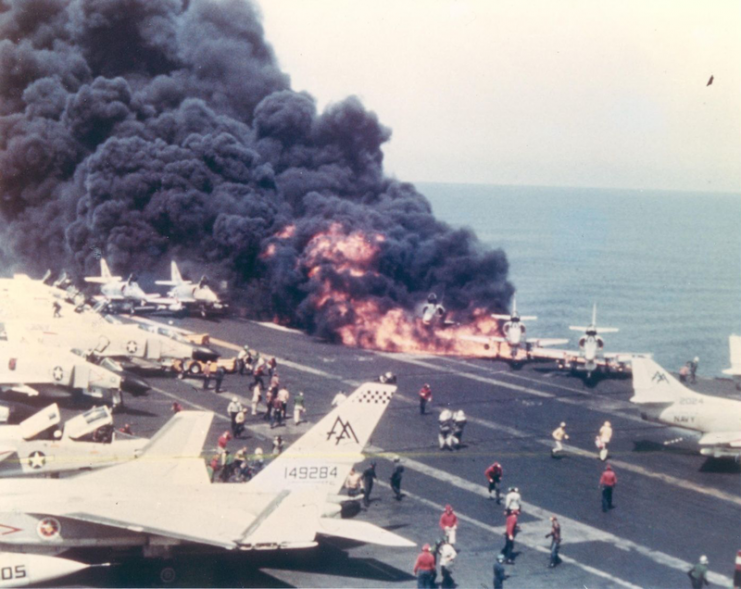
In the blink of an eye, flames engulfed several aircraft. Future Senator John McCain, back then a Naval aviator, managed to escape from his own A-4 as Chief Aviation Boatswain’s Mate Gerald Farrier began fighting the fire with a Purple-K canister, trying to help other pilots who were trapped in the flames. McCain got away in the nick of time, as the AN-M65 bombs too quickly yielded their devastating payload.
Words fail to succinctly describe the horror of the catastrophic chain reaction of explosions. The first bomb “cooked off” a mere 90 seconds after the fire began. At least 8 explosions wiped out two firefighting teams and tore gaping holes in the flight deck, and the fire raged out of control. Burning jet fuel poured into the holes and down the sides of the ship, expanding the fire to multiple decks below.
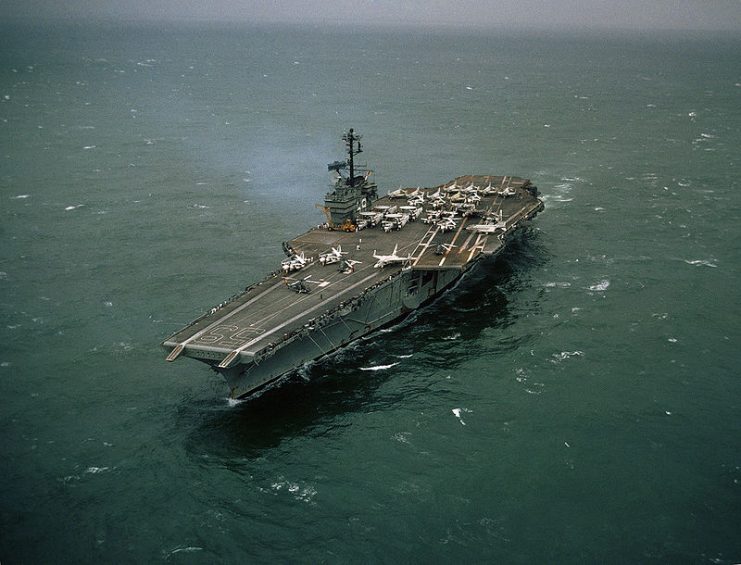
When the explosions subsided, Forrestal‘s sailors heroically set out to save their ship, and finally extinguished the last of the flames at 4 AM the next day. Unfortunately, their lack of training in some cases caused more trouble. Foam hose teams spread protective foam only to see water hose teams wash it away. Water hose teams also caused additional damage by unnecessarily flooding spaces untouched by the fire.
In the end, the casualties were 134 killed, 161 injured, 20 aircraft destroyed, and $72 million in damage to the ship. Forrestal was effectively knocked out of the Vietnam War, and would take 2 years to repair.
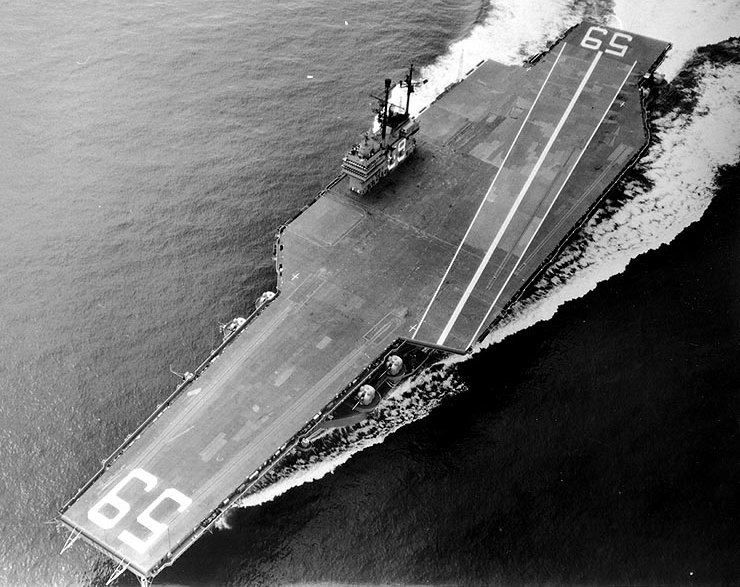
The video recording of the inferno from Forrestal‘s PLAT camera was incorporated into the previously mentioned Trial By Fire film. For years afterward, countless sailors watched it as part of training classes. The Navy named its new firefighting school in Norfolk in honor of Chief Farrier, immortalized as “the Chief with the Purple-K” in the film.
The Navy made many changes to its policies and damage control equipment as a direct result of the fire. Most notably, firefighting and damage control training became mandatory for crewmembers on every Navy ship.
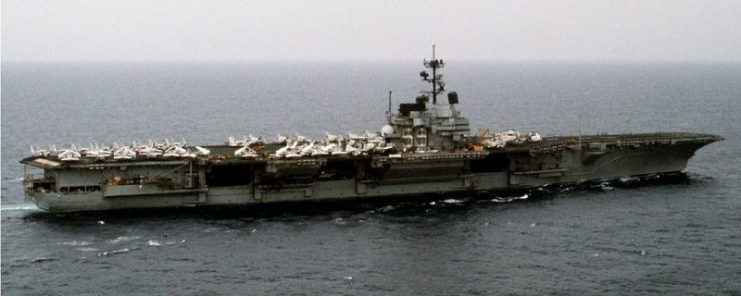
USS Enterprise (CVAN 65), January 14, 1969
A Zuni rocket was once again the catalyst the third time disaster struck an aircraft carrier during the Vietnam War. This time, it was Enterprise that relived an experience similar to Forrestal‘s: 8 major explosions and a raging fire. Enterprise, however, saw some significant differences.
Unlike Oriskany or Forrestal, Enterprise was not in a combat situation. She was near Hawaii, in the middle of what probably many sailors would agree was the second worst time to have a disastrous fire onboard—an Operational Readiness Inspection (ORI).
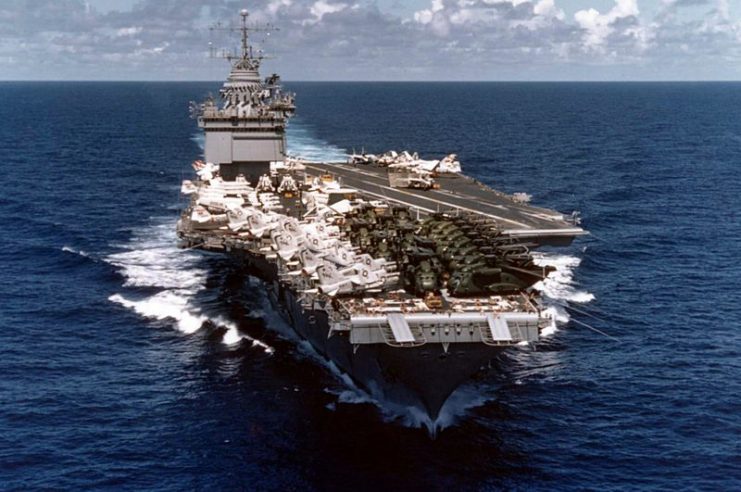
16 armed aircraft were scheduled to launch at 8:30 AM. Around 8:15, according to the Navy JAG investigation afterward, “an MD-3A jet aircraft starter unit was positioned on the starboard side of an F-4J…such that its exhaust outlet was in line with and within twenty-four inches of a loaded LAU-10 ZUNI rocket launcher mounted on the starboard wing of the aircraft.”
Although several people, including one of the ORI inspectors, observed the exhaust from the improperly parked “huffer” heating the rockets, no one took definite action. An overheated rocket exploded, beginning the exact same chain reaction that had occurred on Forrestal: punctured fuel tanks spilled fuel that ignited, which in turn detonated ordnance.
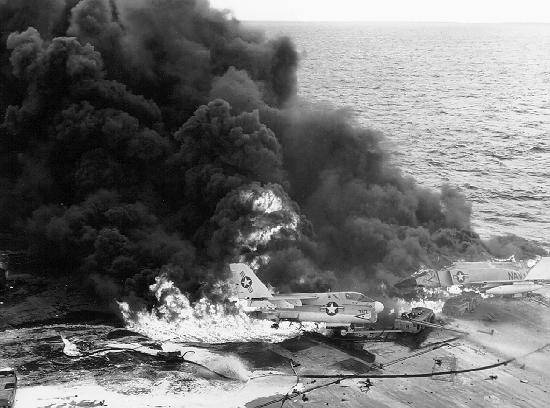
As with Forrestal, holes blown in the flight deck allowed burning fuel to enter the interior of the ship. But thanks to Forrestal, nearly all of Enterprise‘s ship’s company and the majority of its embarked air wing had been trained in firefighting, which proved invaluable.
Another major difference in Enterprise‘s case is that the modern bombs involved did not detonate immediately, buying time for sailors to jettison other ordnance near the fire. The Captain turned the ship so that the wind blew the flames clear of undamaged aircraft, which also helped prevent the fire from spreading across the flight deck. By 11:38, all fires were extinguished.
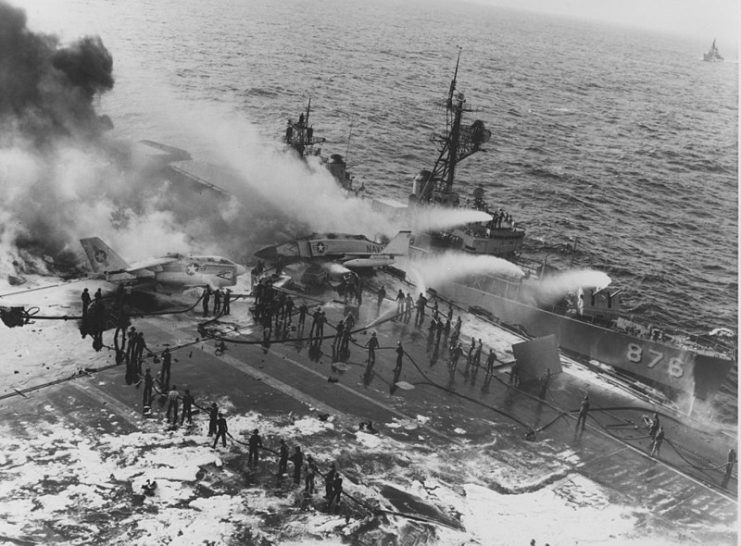
Enterprise‘s casualties were 27 dead and 371 injured. Damage to the ship was estimated to be over $10 million. In addition, 15 aircraft were destroyed and 17 damaged, costing another estimated $44 million.
The investigative report concluded that “sound damage control organization, training and execution minimized casualties and prevented the initial fire from spreading beyond the Fly Three area of the flight deck to any significant degree.” The report also indicated, however, that flight deck personnel were still largely deficient in knowledge of weapons specifics, such as their cook-off times.
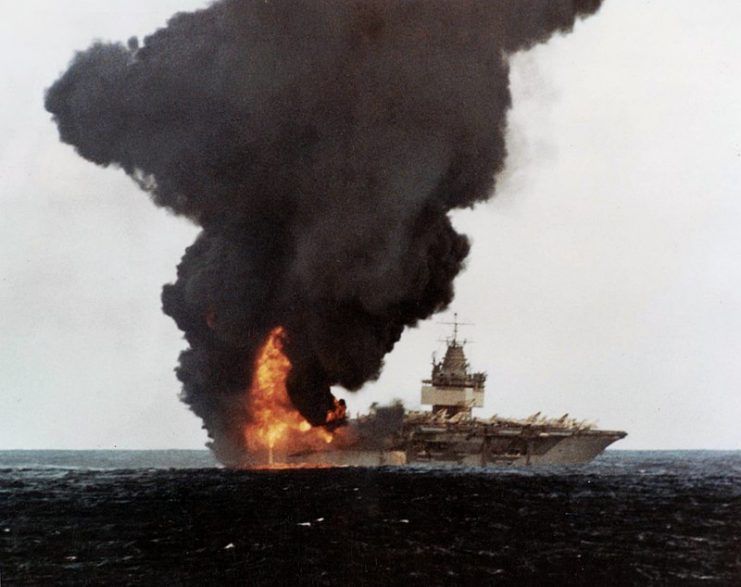
Legacy of the 1960’s
Mishaps, some fatal, inevitably still occur on carriers. USS Nimitz (CVN 68) in 1981 experienced a similar fuel and ordnance fire as the carriers of the 60’s, although on a smaller scale. But overall, the “lessons learned” in the 60’s resulted in improved policies, procedures, and equipment that have been largely effective at preventing a repeat. Forrestal particularly was a milestone in the Navy’s change of approach toward firefighting.
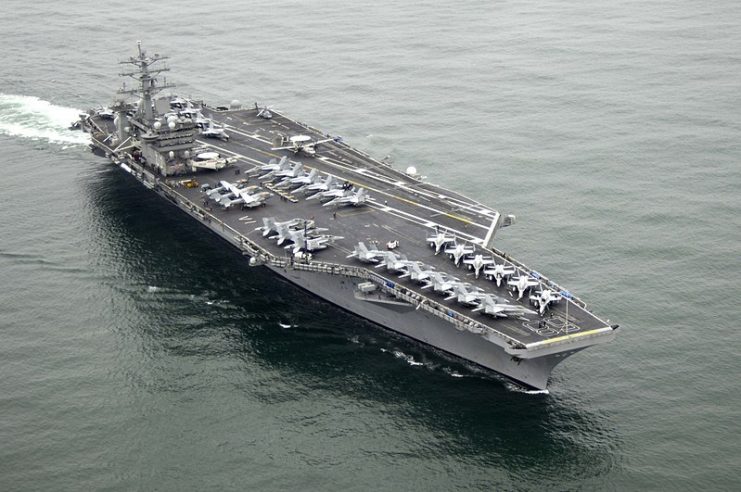
However, the “entirely preventable” 2008 fire aboard USS George Washington (CVN 73) was a grim reminder that even the most ironclad regulations and procedures can sometimes be no match for fatigue, laziness, ignorance, or haste, not to mention freak accidents.
George Washington‘s fire, which originated below decks and fortunately did not involve weapons, resulted in $70 million in damages and 37 sailors injured, but no fatalities. In wartime, as other carriers can attest, adding weapons and aviation fuel to any of those human factors can make the outcome far more deadly.
